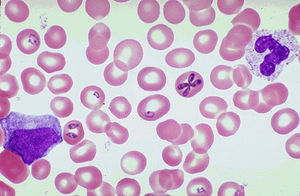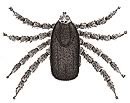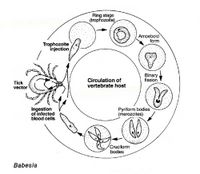Babesia
A Microbial Biorealm page on the genus Babesia

Classification
Higher order taxa:
Eukaryota; Alveolata; Apicomplexa; Piroplasmida; Babesiidae
Species:
Babesia bicornis, B. bigemina, B. bovis, B. caballi, B. canis, B. capreoli, B. conradae, B. crassa, B. cf. crassa GU184, B. divergens, B. duncani, B. equi, B. felis, B. gibsoni, B. leo, B. lotori, B. major, B. microti, B. cf. microti, B. motasi, B. muratovi, B. odocoilei, B. orientalis, B. ovata, B. ovis, B. poelea, B. rodhaini, B. rossi, B. vesperuginis, B. sp.
|
NCBI: Taxonomy Genome |
Description and Significance
Babesia is a genus of parasitic protozoans which affect several vertebrates, including (though rarely) humans. Babesiosis, the disease caused by the Babesia parasite, is most common among dogs, cattle, horses, and rodents. All members of Babesia exhibit two life cycles: one in the invertebrate host (almost always ticks) and one in the vertebrate host. Common symptoms include fever, anemia, fatigue, aches, chills, red urine, and possibly eventual death. Babesiosis is known as "Texas cattle fever" among bovines. Humans may be subjected to the parasites through cattle (Babesia bovis) or rodents (Babesia microti), but only a few cases are reported each year, usually among the elderly or those with compromised immune systems. Kennels or stables with weak tick-prevention systems may be particularly susceptible to outbreaks of the disease. Treatment is often unreliable or not available in the United States, and many of the medications available may cause severe side effects. Humans with babesiosis are usually treated with malaria remedies.
Genome Structure
Because of the need for a vaccine, the genome sequence of Babesia bovis is currently being mapped.
Cell Structure and Metabolism
When an infected tick feeds on a vertebrate host, the Babesia parasite enters the host in trophozoite ("ring") form. The trophozoites invade the host's red blood cells, where they multiply through binary fission. It is here that the merozoite form of Babesia wreaks the most havoc on the host, as it destroys red blood cells and causes anemia. Uninfected ticks ingest the vertebrate's blood when feeding, and the merozoitic parasites settle in the midgut. After multiplying in the vector's gut, Babesia migrates to the salivary glands, ready to be spread to a new vertebrate host. Like all apicomplexans, Babesia's cells invade the host's red blood cells by way of the apicoplast, an organelle unique to members of this phylum. See Apicomplex for more details.
Ecology

Babesia is a group of parasites which are transmitted from host to host through an intermediate tick host. Most Babesia species are host-specific, so Babesia bovis is found on cattle farms and ranches, Babesia canis is prevalent in kennels and dog-breeding facilities, etc. Distribution is worldwide, although in some malaria-endemic countries it may be misdiagnosed, as the symptoms are often similar. Widespread areas in Africa, South and Central America, the United States, and Australia are under threat of Babesia bovis. Areas with a large number of tick-prone animals are constantly at risk for the parasite.
References
Babesia Canis. Atlas of Medical Parasitology, Carlo Denegri Foundation.
Babesia Infection in Dogs. Mar Vista Animal Medical Center.
Babesia Project. School of Veterinary Medicine, University of California-Davis.

